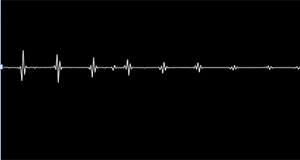SYSTEM ERROR / Installation 2017
Digitalprint, Beamer / Stift Klosterneuburg-Beitrag zum Friedenspreis 2021
| Das von der amerikanischen Navy entwickelte „Low Frequency Active Sonar“ (LFAS) schickt extrem laute Niederfrequenz-Schallwellen in die Meere und soll damit ermöglichen, fast lautlos dahingleitende Atom-U-Boote aufzuspüren. Die Nebenwirkungen der Spähakustik schätzen Tierschützer jedoch als fatal ein. „Der Einsatz dieser Sonare kann gravierende Folgen für Wale und andere Meeresbewohner haben“, sagt Nicolas Entrup von der „Whale and Dolphin Conservation Society. Besonders Lautstärke und Frequenz des LFAS-Systems geben Walforschern Grund zur Besorgnis. Die Geräte senden Schallwellen mit einem Pegel von bis zu 230 Dezibel ins Wasser und sind damit ungefähr genau so laut wie eine unterseeische Vulkaneruption. Gleichzeitig nutzt die Technik sehr niedrige Frequenzen zwischen 100 und 500 Hertz, die sich über extrem weite Strecken im Wasser ausbreiten. „Die Geräusche eines LFA-Sonars sind in einem Gebiet von bis zu 800.000 Quadratkilometer Größe zu hören“, erläutert Linda Weilgart, Bioakustikerin am Max-Planck-Institut für Verhaltensphysiologie Seewiesen: „Damit sind die Systeme lauter als fast alles, was in den Meeren sonst noch Geräusche von sich gibt.“ Für Wale und Delfine kann der infernalische Krach schnell zum Problem werden, weil sie selbst Sonarortungssysteme verwenden. „Wale nutzen Geräusche zur Kommunikation, zur Orientierung, zur Partnersuche und um Beute oder Räuber unter Wasser zu orten“, sagt Weilgart. |
Auszug aus dem Spiegel online Februar 2001 und 2017
system error
Whale songs
| The „Low Frequency Active Sonar“ (LFAS) developed by the American Navy sends extremely loud low-frequency sound waves into the oceans and is thus intended to make it possible to detect nuclear submarines gliding almost silently. However, animal rights activists consider the side effects of spying acoustics to be fatal. „The use of these sonars can have serious consequences for whales and other marine life,“ says Nicolas Entrup of the Whale and Dolphin Conservation Society. For whales and dolphins infernal noise can quickly become a problem because they use sonar detection systems themselves. „Whales use sounds for communication, orientation, mate hunting and to locate prey or predators underwater“, says Weilgart. Especially the volume and frequency of the LFAS system give whale researchers cause for concern. The devices send sound waves with a level of up to 230 decibels into the water and are thus about as loud as a submarine volcanic eruption. At the same time the technology uses very low frequencies between 100 and 500 Hertz, which spread over extremely long distances in the water. „The sounds of an LFA sonar can be heard in an area of up to 800,000 square kilometers in size“, explains Linda Weilgart, bioacoustician at the Max Planck Institute of Behavioral Physiology Seewiesen: „This makes the systems louder than almost anything else that makes noise in the oceans.“ |
Excerpt from Spiegel online February 2001 and 2017


